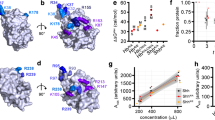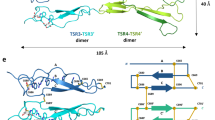Abstract
Heparan sulphate proteoglycans are abundant cell-surface molecules that consist of a protein core to which heparan sulphate glycosaminoglycan chains are attached. The functions of these molecules have remained mostly underappreciated by developmental biologists; however, the actions of important signalling molecules, for example Wnt and Hedgehog, depend on them. To understand both the mechanisms by which ligands involved in development interact with their receptors and how morphogens pattern tissues, biologists need to consider the functions of heparan sulphate proteoglycans in signalling and developmental patterning.
This is a preview of subscription content, access via your institution
Access options
Subscribe to this journal
Receive 51 print issues and online access
$199.00 per year
only $3.90 per issue
Buy this article
- Purchase on Springer Link
- Instant access to full article PDF
Prices may be subject to local taxes which are calculated during checkout


Similar content being viewed by others
References
Bernfield,M. et al. Biology of the syndecans: a family of transmembrane heparan sulfate proteoglycans. Annu. Rev. Cell Biol. 8, 365–393 (1992).
Bernfield,M. et al. Functions of cell surface heparan sulfate proteoglycans. Annu. Rev. Biochem. 68, 729–777 (1999).
Habuchi,H., Habuchi,O. & Kimata,K. Biosynthesis of heparan sulfate and heparin. How are the multifunctional glycosaminoglycans built up? Trends Glycosci. Glycotechnol. 10, 65–80 ( 1998).
Rosenberg,R. D., Shworak,N. W., Liu,J., Schwartz,J. J. & Zhang, L. Heparan sulfate proteoglycans of the cardiovascular system. Specific structures emerge but how is synthesis regulated? J. Clin. Invest. 99, 2062–2072 (1997).
Lindahl,U., Kusche-Gullberg,M. & Kjellén,L. Regulated diversity of heparan sulfate. J. Biol. Chem. 273, 24979– 24982 (1998).
Lyon,M. & Gallagher,J. T. Bio-specific sequences and domains in heparan sulfate and the regulation of cell growth and adhesion. Matrix Biol. 17, 485–493 (1998).
Lindahl,U. Heparin (CRC, Boca Raton, Florida, 1989).
Iozzo,R. V. Matrix proteoglycans: from molecular design to cellular function. Annu. Rev. Biochem. 67, 609–652 (1998).
Nakato,H., Futch,T. A. & Selleck, S. B. The division abnormally delayed (dally) gene: a putative integral membrane proteoglycan required for cell division patterning during postembryonic development of the nervous system in Drosophila. Development 121, 3687– 3702 (1995).
Veugelers,M. & David,G. The glypicans: a family of GPI-anchored heparan sulfate proteoglycans with a potential role in the control of cell division. Trends Glycosci. Glycotechnol. 10, 145–152 (1998).
Fitzgerald,M. L. et al. Shedding of syndecan-1 and -4 ectodomains is regulated by multiple signaling pathways and mediated by a TIMP-3 sensitive metalloproteinase. J. Cell. Biol. 148, 811– 824 (2000).
Subramanian,S. V., Fitzgerald,M. L. & Bernfield, M. Regulated shedding of syndecan-1 and -4 ectodomains by thrombin and growth factor activation. J. Biol. Chem. 272, 14713–14720 (1997).
Kato,M. Physiological degradation converts the soluble syndecan-1 ectodomain from an inhibitor to a potent activator of FGF-2. Nature Med. 4, 691–697 (1998).
Kainulainen,V., Wang,H., Schick,C. & Bernfield,M. Syndecans, heparan sulfate proteoglycans, maintain the proteolytic balance of acute wound fluids. J. Biol. Chem. 273, 11563– 11569 (1998).
Binari,R. C. et al. Genetic evidence that heparin-like glycosaminoglycans are involved in wingless signaling. Development 124, 2623–2632 (1997).
Haecker,U., Lin,X. & Perrimon,N. The Drosophila sugarless gene modulates Wingless signaling and encodes an enzyme involved in polysaccharide. Development 124 , 3565–3573 (1997).
Haerry,T. E., Heslip,T. R., Marsh,J. L. & O'Conner,M. B. Defects in glucuronate biosynthesis disrupt Wingless signaling in Drosophila. Development 124, 3055– 3064. (1997).
Lin,X. & Perrimon,N. Dally cooperates with Drosophila Frizzled 2 to transduce Wingless signalling. Nature 400, 281–284 (1999).
Bellaiche,Y., The,I. & Perrimon,N. Tout-velu is a Drosophila homologue of the putative tumour suppressor EXT-1 and is needed for Hh diffusion. Nature 394, 85–88 (1998).
The,I., Bellaiche,Y. & Perrimon, N. Evidence that heparan sulfate proteoglycans are involved in the movement of Hedgehog molecules through fields of cells. Mol. Cell 4, 633–639 ( 1999).
Stickens,D. et al. The EXT2 multiple exostoses gene defines a family of putative tumour suppressor genes. Nature Genet. 14, 25–32 (1996).
McCormick,C. et al. The putative tumour suppressor EXT1 alters the expression of cell-surface heparan sulfate. Nature Genet. 19, 158–161 (1998).
Lind,T., Tufaro,F., McCormick,C., Lindahl,U. & Lidholt, K. The putative tumor suppressors EXT1 and EXT2 are glycosyltransferases required for the biosynthesis of heparan sulfate. J. Biol. Chem. 273, 26265–26268 ( 1998).
Toyoda,H., Kinoshita-Toyoda,A. & Selleck, S. B. Structural analysis of glycosaminoglycans in Drosophila and C.elegans and demonstration that tout velu, a Drosophila gene related to EXT tumor suppressors, affects heparan sulfate in vivo. J. Biol. Chem. 275, 2269–2275 (2000).
Sen,J., Goltz,J. S., Stevens,L. & Stein,D. Spatially restricted expression of pipe in the Drosophila egg chamber defines embryonic dorsal-ventral polarity. Cell 95, 471– 481 (1998).
Bullock,S. L., Fletcher,J. M., Beddington, R. S. P. & Wilson,V. A. Renal agenesis in mice homozygous for a gene trap mutation in the gene encoding heparan sulfate 2-sulfotransferase. Genes Dev. 12, 1894–1906 (1998).
Forsberg,E. et al. Abnormal mast cells in mice deficient in a heparin-synthesizing enzyme. Nature 400, 773– 776 (1999).
Humphries,D. E. et al. Heparin is essential for the storage of specific granule proteases in mast cells. Nature 400, 769– 772 (1999).
Kato,M., Wang,H., Bernfield,M., Gallagher,J. T. & Turnbull, J. E. Cell surface syndecan-1 on distinct cell types differs in fine structure and ligand binding of its heparan sulfate chains. J. Biol. Chem. 269, 18881–18890 (1994).
Sanderson,R. D., Turnbull,J. E., Gallagher, J. T. & Lander,A. D. Fine structure of heparan sulfate regulates syndecan-1 function and cell behavior. J. Biol. Chem. 269, 13100– 13106 (1994).
Nurcombe,V., Ford,M. D., Wildschut,J. A. & Bartlett,P. F. Developmental regulation of neural response to FGF-1 and FGF-2 by heparan sulfate proteoglycan. Science 260, 103– 106 (1993).
Tsuda,M. et al. The cell-surface proteoglycan Dally regulates Wingless signalling in Drosophila. Nature 400, 276– 280 (1999).
Cadigan,K. M., Fish,M. P., Rulifson,E. J. & Nusse,R. Wingless repression of Drosophila frizzled 2 expression shapes the Wingless morphogen gradient in the wing. Cell 93, 767–777 (1998).
Jackson,S. M. et al. Dally, a Drosophila glypican, controls cellular responses to the TGF-β-related morphogen, Dpp. Development 124, 4113–4120 (1997).
Gonzalez,A. D. et al. OCI-5/GPC3, a glypican encoded by a gene that is mutated in the Simpson- Golabi-Behmel overgrowth syndrome, induces apoptosis in a cell line- specific manner. J. Cell Biol. 141, 1407–1414 (1998).
Pilia,G. et al. Mutations in GPC3, a glypican gene, cause the Simpson-Golabi-Behmel overgrowth syndrome. Nature Genet. 12, 241 –247 (1996).
Alexander,C. M. et al. Syndecan-1 is required for Wnt-1-induced mammary tumorigenesis in mice. Nature Genet. (in the press).
Kitagawa,H., Shimakawa,H. & Sugahara, K. The tumor suppressor EXT-like gene EXTL-2 encodes an alpha1,4-N-acetylhexosaminyltransferase that transfers N-acetylgalactosamine and N-acetylglucosamine to the common glycosaminoglycan-protein liknkage region. The key enzyme for the chain initiation of heparan sulfate. J. Biol. Chem. 274, 13933–13937 (1999).
Rubin,G. M. et al. Comparative genomics of the eukaryotes. Science 287, 2204–2215 ( 2000).
Acknowledgements
This work was supported by the NIH (MB). N.P. is an Investigator of the Howard Hughes Medical Institute.
Author information
Authors and Affiliations
Rights and permissions
About this article
Cite this article
Perrimon, N., Bernfield, M. Specificities of heparan sulphate proteoglycans in developmental processes . Nature 404, 725–728 (2000). https://doi.org/10.1038/35008000
Received:
Accepted:
Issue Date:
DOI: https://doi.org/10.1038/35008000
This article is cited by
-
Structural analysis of glycosaminoglycans from Oviductus ranae
Glycoconjugate Journal (2021)
-
Endocan, a novel inflammatory marker, is upregulated in human chondrocytes stimulated with IL-1 beta
Molecular and Cellular Biochemistry (2021)
-
Chondroitin polymerizing factor (CHPF) promotes development of malignant melanoma through regulation of CDK1
Cell Death & Disease (2020)
-
Structural analysis of glycosaminoglycans from Colla corii asini by liquid chromatography-electrospray ion trap mass spectrometry
Glycoconjugate Journal (2020)
Comments
By submitting a comment you agree to abide by our Terms and Community Guidelines. If you find something abusive or that does not comply with our terms or guidelines please flag it as inappropriate.



